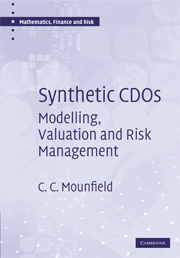Book contents
- Frontmatter
- Contents
- Preface
- Acknowledgements
- 1 A primer on collateralised debt obligations
- 2 Modelling of obligor default
- 3 Valuation of credit default swaps
- 4 Credit indices
- 5 Valuation of default baskets
- 6 Valuation of synthetic CDOs
- 7 Phenomenology of the standard market model
- 8 Risk quantification of synthetic CDOs
- 9 Implied and base correlations
- 10 Extensions of the standard market model
- 11 Exotic CDOs
- 12 Correlation trading of synthetic CDO tranches
- 13 Risk management of a portfolio of synthetic CDOs
- 14 Hedging simulation of structured credit products
- Appendix A Explanation of common notation
- Appendix B Simulated annealing
- References
- Index
6 - Valuation of synthetic CDOs
Published online by Cambridge University Press: 06 July 2010
- Frontmatter
- Contents
- Preface
- Acknowledgements
- 1 A primer on collateralised debt obligations
- 2 Modelling of obligor default
- 3 Valuation of credit default swaps
- 4 Credit indices
- 5 Valuation of default baskets
- 6 Valuation of synthetic CDOs
- 7 Phenomenology of the standard market model
- 8 Risk quantification of synthetic CDOs
- 9 Implied and base correlations
- 10 Extensions of the standard market model
- 11 Exotic CDOs
- 12 Correlation trading of synthetic CDO tranches
- 13 Risk management of a portfolio of synthetic CDOs
- 14 Hedging simulation of structured credit products
- Appendix A Explanation of common notation
- Appendix B Simulated annealing
- References
- Index
Summary
Introduction
In this chapter we construct and analyse a number of different models for the valuation of synthetic CDO tranches. Subsequent chapters will extend the models and analysis introduced so it is a very important chapter to the overall scope of the text. As we will see, much of the preceding discussion on valuation of default baskets will prove to be of use here.
This chapter begins in Section 6.2 with a description of the cashflow mechanics of synthetic CDOs, highlighting a number of important features that a suitable model must capture. The basic principles of synthetic CDO pricing are introduced in Section 6.3. As we will see in this section, the key quantity to determine when valuing a synthetic CDO is the portfolio loss distribution. The remainder of the chapter is devoted to describing different methods for the construction of the portfolio loss distribution. Section 6.4 describes the Monte Carlo method for implementing the standard market model. As was found for default baskets in the previous chapter, the Monte Carlo method is a flexible and intuitive methodology, but the problems of simulation noise are ever present. This coupled with the typically large size of the underlying pool in a tranche make the Monte Carlo method unsuitable for many time-critical applications within a bank (such as revaluation of a tranche portfolio for the purposes of calculating value-at-risk (VaR) numbers).
- Type
- Chapter
- Information
- Synthetic CDOsModelling, Valuation and Risk Management, pp. 110 - 136Publisher: Cambridge University PressPrint publication year: 2008
- 1
- Cited by



